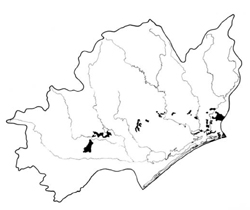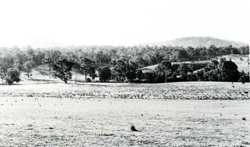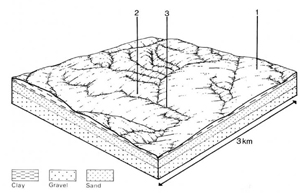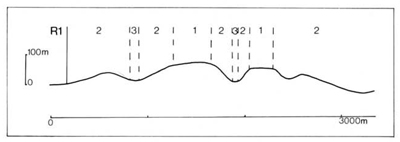Westbury 1 (W1)
 | Area: 166 sq. km (0.8%) Westbury 1 land system occurs on the earlier Pleistocene terrace and on the more distal parts of the Tertiary flood plain deposits. These deposits have been dissected to form low hills and sloping to undulating plains and most of the original land surface has been removed. Westbury 1 differs from Westbury 2 land system in having a drier climate with associated changes in vegetation and from Redgum 1 land system in having greater relief. The materials of Tertiary and Early Pleistocene deposits were pre-weathered and further weathering has taken place. The soils are deep, leached and almost invariably have yellowish brown duplex profiles. There is some variation in texture and consistence of the topsoil, in the degree of subsurface mottling and in the reaction of the lower subsoil which may range from strongly acid to neutral. The subsoils with neutral reaction are probably highly dispersible and prone to gully erosion. The remaining native vegetation is mainly an open forest II, often shrubby. Similar vegetation was probably predominant prior to clearing. |  The cleared gentle slopes contrast with the timbered steeper slopes of the Tambo land system. |
| CLIMATE Rainfall, mean (mm) Temperature, mean (°C) Seasonal growth limitations | Annual 600 - 900; lowest July or August (30 - 50), highest October (50 - 80) Annual 12 - 14; lowest July (8 - 10), highest February (19 - 21) Temperature <10°C (av.): June - August Rainfall < potential evapotranspiration: November – March |
| GEOLOGY Age, lithology | Distal parts of Tertiary floodplain deposits and some Lower Pleistocene terrace deposits; gravels, sands, silts and clays |
| PHYSIOGRAPHY Landscape Elevation range (m) Relative relief (m) Drainage pattern Drainage density (km/km2) | Sloping to undulating plains and low hills 0 - 200 10 - 120 Dendritic 1.0 |
| PRESENT LAND USE | Mostly cleared: grazing of beef cattle and sheep on improved pastures; softwood plantations (limited) Minor proportion uncleared: bush grazing of cattle (limited); apiculture |
 |  |
| LAND COMPONENT Percentage of land system Diagnostic features | 1 10 Almost flat plateaux remnants | 2 80 Gentle to moderate slopes, rarely steep | 3 10 Drainage depressions, in places permanently wet |
| PHYSIOGRAPHY Slope %, typical and (range) Slope shape | 2, (0 - 5) Straight | 4 - 8, (0 - 15) Variable | 2, (0 - 5) Concave |
| SOIL | |||
| Parent material | Mainly clay, silt and sand with some intermixed quartz gravel | Locally derived alluvium | |
| Description | Very dark greyish brown, sometimes black, sand to sandy clay loam topsoil grading into greyish brown or yellowish brown sandy clay loam subsurface soil, sometimes mottled. Abrupt change to yellowish brown, dark yellowish brown or reddish brown strongly mottled clay subsoil. Subsoil generally moderately to strongly acidic, sometimes neutral at depth | Limited observations — probably variable; dark grey deep sand and strongly mottled grey clay; soil reaction acidic | |
| Classification | Mostly Yellow Podzolic Soils; some Solodic Soils, Soloths; rarely Brown or Red Podzolic Soils Dy3.21, Dy3.41, Dy3.42, Dy3.31, Dy2.21; rarely Db2.11, Db2.21, Db4.21, Dr5.21 | Alluvial Soils, Humic Gleys Uc1.21, Gn3.91 | |
| Surface Texture | Sand to sandy clay loam; mostly sandy loam | Sand to sandy clay loam | |
| Surface consistence | Friable when moist | Friable when moist | |
| Depth (m) | >2.0 | >2.0 | |
| Nutrient status | Low | Low | |
| Available soil water capacity | Moderate | Variable | |
| Perviousness to water | Very slow to slow | Very variable | |
| Drainage | Mostly somewhat poor | Mostly very poor to poor | |
| Exposed stone (%) | Usually 0 | 0 | |
| Sampled profile number | 55, 67 | 49, 51 | - |
| NATIVE VEGETATION Structure of vegetation and characteristic species of dominant stratum (+ Predominant species) | Open forest II, often shrubby: Mainly mixed forests, though occasionally pure stands, species including — E. globoidea, E. sieberi (most common predominants), E. tereticornis, E. bosistoana, E. cypellocarpa, E. baxteri (often predominant), E. melliodora and E. sideroxylon | Open forest II, III often shrubby: E. bridgesiana+ and/or E. globulus+ often occurring in association with E. ovata, E. radiata or E. melliodora | |
|
|
|
|
| ||
|
|
| ||||
— reduction in leaf area, rooting depth and/or perenniality |
resulting in increased deep percolation |
|
|
|
|
|
|
|
|
2; moderate |
|
|
|
|
With Reduced infiltration |
Sheet and rill erosion |
3; low – high 1; low 2; moderate |
Not determined |
As for sheet and rill erosion above |
Increased flash flows |
|
|
|
2; moderate |
|
|
|
| ||||||


